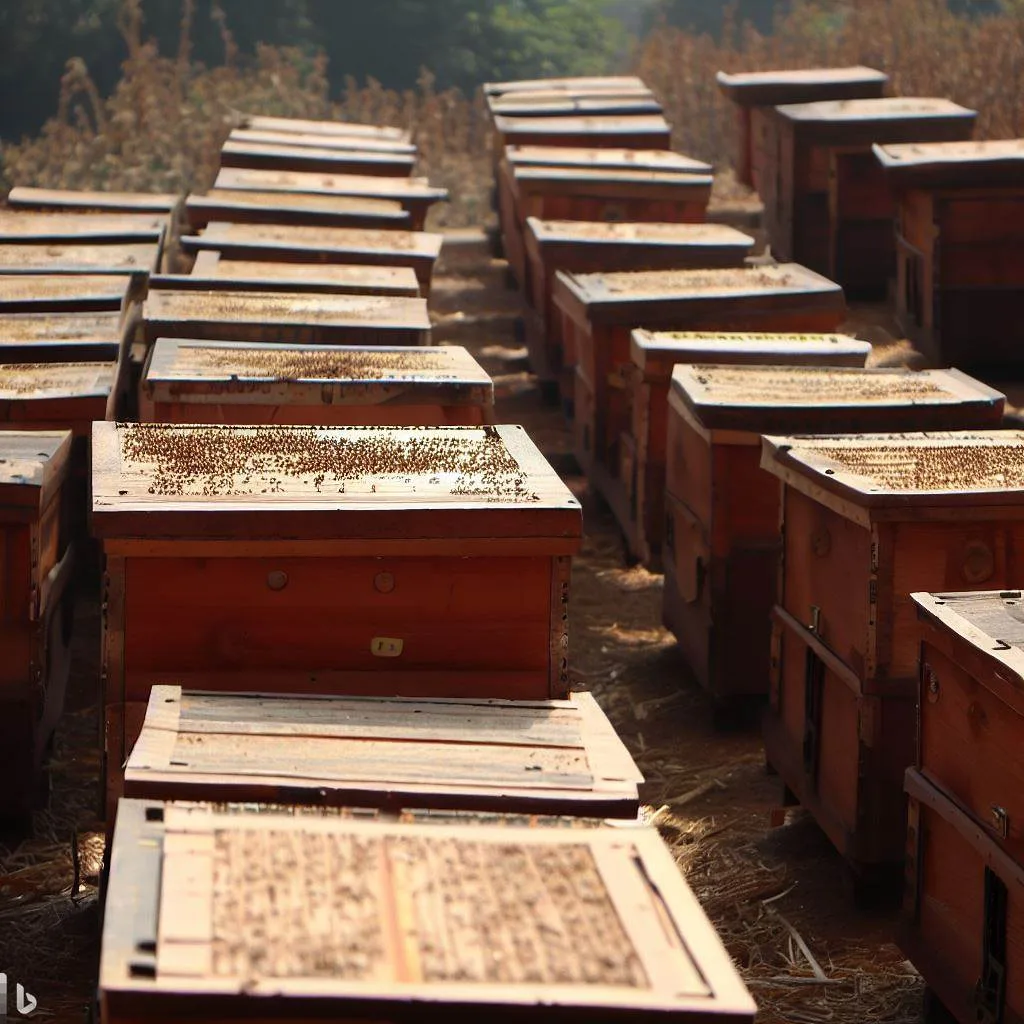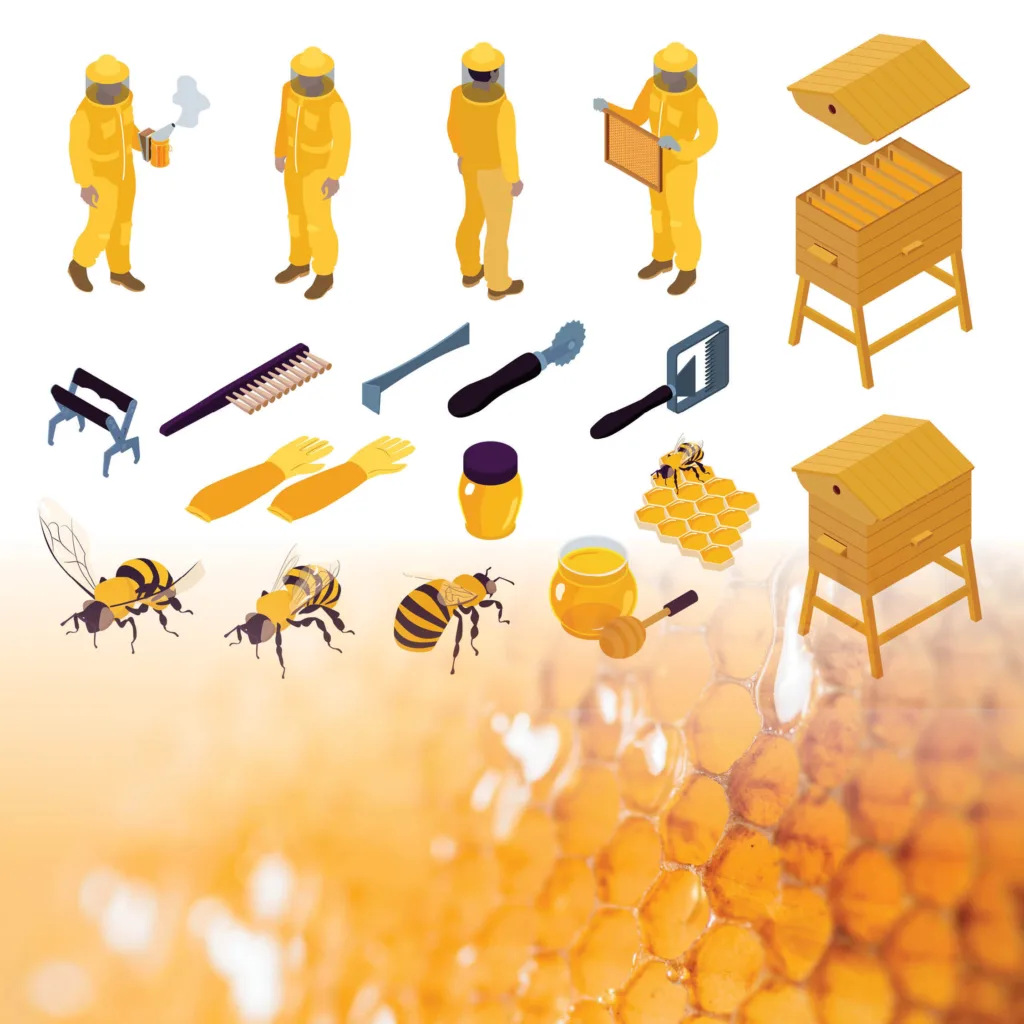Agriculture is the backbone of India’s economy, contributing to a significant portion of the nation’s GDP. One innovative and lucrative sector within agriculture is honey bee farming. As the demand for natural honey increases domestically and internationally, this venture can be a source of significant income and an excellent choice for Agripreneurship.

Understanding Honey Bee Farming
Honey bee farming, also known as apiculture, involves the maintenance of bee colonies in crafted hives. Bees collect nectar from flowers and convert it into honey. In the process, they also aid in pollination, contributing to the overall ecosystem.
Four Main Types of Honey Bees
There are several types of bees, but four main species are predominantly used in honey farming in India. Each species contributes uniquely to honey production.
- Apis Dorsata: Also known as the rock bee or giant honey bee, it is the largest honey bee in India and produces a significant amount of honey.
- Apis Cerana Indica: Known as the Indian bee, it is commonly used in traditional beekeeping due to its adaptability to local conditions.
- Apis Mellifera: Often referred to as the Italian bee, it’s known for its high honey production and is frequently used in modern honey bee farming.
- Apis Florea: A dwarf bee species, producing less honey but easy to maintain due to its manageable colony size.
Pros and Cons of Honey Bees in Honey Bee Farming
Honey bees are integral to honey bee farming. However, there are various pros and cons associated with these tiny creatures that one must consider when starting a honey farm.
Pros
- Honey Production: Honey bees are prolific producers of honey, a high-demand product with numerous health and culinary uses.
- Pollination: Honey bees contribute significantly to the pollination of agricultural crops and other flora, helping to improve crop yields and biodiversity.
- Wax and Other Products: Apart from honey, bees also produce wax, propolis and royal jelly, all of which have substantial commercial value.
Cons
- Bee Health Management: Honey bees are susceptible to diseases, pests, and parasites, which require continuous monitoring and management to maintain a healthy colony.
- Swarming: Bees naturally swarm (split their colony) as a method of propagation, which can lead to loss of half the hive if not properly managed.
- Climate Sensitivity: Extreme weather conditions can negatively impact the health of a bee colony, affecting honey production.
Understanding the Castes of Honey Bees
A bee colony is composed of three castes: the Queen, the Worker Bees and the Drones.
- The Queen: The sole reproductive female in the hive. Her primary role is to lay eggs to ensure the growth and survival of the colony.
- Worker Bees: These are infertile females that perform various tasks, including foraging for nectar and pollen, caring for the queen and larvae and guarding the hive.
- Drones: The male bees, their main purpose is to mate with a new queen.

Advancements in Honey Bee Farming Technologies
- Remote Beehive Monitoring: IoT devices can monitor hive health, temperature, humidity, and other parameters remotely.
- Automated Honey Extractors: These devices minimize damage to the bees and the hive during the extraction process.
- Bee Robotic Pollinators: In areas where there is a decline in the bee population, robotic pollinators can be used to assist in the pollination of crops.
Post-Honey Extraction Steps
After extraction, honey is usually filtered to remove any impurities. It’s not advised to add any additives to honey as it alters the natural taste and may compromise its quality. Natural flavours can be obtained by shifting bee boxes to different flower sources. For example, moving hives to mustard fields gives honey a distinctive pungent flavour.
Honey Bees Used Across Different States in India
- Kerala, Tamil Nadu, and Karnataka: The Apis Cerana Indica or the Indian bee is popular here due to its adaptability to tropical climates.
- Himachal Pradesh and Uttarakhand: The Apis Mellifera thrives in these cooler, hilly regions, producing high-quality honey.
- Assam and West Bengal: The Apis Dorsata or rock bee is common in these regions due to the ample forest cover.

The Most Profitable Honey Bee
In terms of profitability, Apis Mellifera comes out on top. These bees produce large quantities of honey, which makes them the bee of choice for commercial honey production. However, the profitability also depends on maintaining the health of the colony, efficient management of the apiary and effective marketing of the produced honey.
Essential Steps for Honey Bee Farming in India
Successful honey bee farming involves a series of steps, from education and planning to harvesting and selling the honey.
- Gain Knowledge and Training: Before you start, master the basics of beekeeping, understand bee biology, learn about the diseases that affect them and discover the methods to prevent those diseases.
- Formulate a Business Plan: Decide on the scale of your operation, whether it’s small-scale or commercial. Identify your target market and outline your marketing strategies.
- Select the Right Bee Species: Different bees suit different climates and types of honey production. In India, beekeepers commonly use Apis Mellifera and Apis Cerana Indica for their high honey yield.
- Procure Necessary Equipment: The primary beekeeping tools include bee boxes, bee veils, bee suits, gloves, hive tools, bee brushes, smokers and extractors.
- Choose a Suitable Location: Choose an easy-to-reach spot for your apiary with nearby water, wind and predator protection and plenty of nectar-rich plants.
- Hive Installation and Bee Colonization: Install your hives and introduce your bees to them. Do this gently and quietly to avoid agitating the bees.
- Regular Hive Management: Regularly inspect the hive for signs of diseases or parasites. Ensure the bees have enough food, especially during periods when nectar is scarce.
- Harvest the Honey: Harvest honey at the end of the blooming season, ensuring you leave enough for the bees to sustain themselves.
- Process and Market the Honey: After harvesting, we process and pack the honey. Create a marketing strategy to sell your honey, considering both local and international markets.

Profitability of Honey Bee Farming
Honey Bee farming in India is highly profitable due to the increasing demand for natural and pure honey. A healthy bee colony can produce 20-25 kg of honey annually. With ten colonies, you can expect a yield of about 200-250 kg of honey per year. The selling price of honey varies, but it typically ranges from Rs. 300-600 per kg. Therefore, the potential income from honey bee farming can be substantial, especially when you consider the number of colonies you maintain. Considering the average market price of natural honey, it presents a significant return on your investment.
The Impact of Honey Farming on Indian Agriculture
Not only does honey bee farming provide a direct income source, but it also significantly contributes to agriculture by boosting crop yield through pollination.
By following these steps and guidelines, you can begin your journey into the world of honey bee farming.
Investing in Honey Bee Farming
Honey bee farming, while profitable, requires an initial investment to cover the cost of bees, equipment, and infrastructure.
Startup Costs
Here’s an approximate cost breakdown for starting a small-scale honey farm with 10 colonies:
- Bee Colonies: An average cost of INR 2000-3000 per colony.
- Equipment: Necessary beekeeping tools like bee boxes, bee veils, bee suits, gloves, hive tools, bee brushes, smokers and extractors can cost around INR 8000-10,000.
- Infrastructure: Rent or acquire suitable land, depending on the scale of operation.
The total initial cost might vary based on factors like location, scale and specific requirements of the farm.



